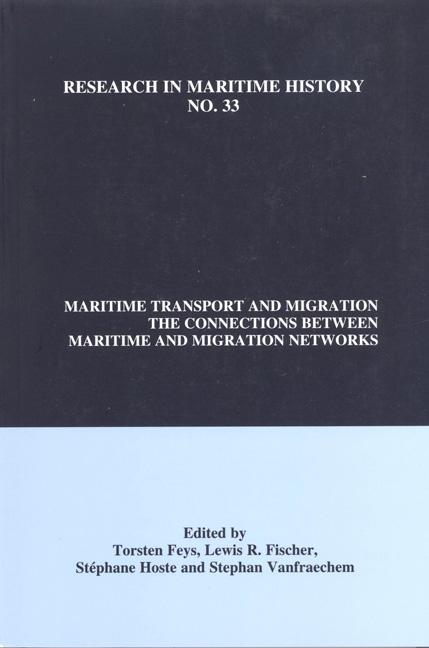Book contents
- Frontmatter
- Contents
- Contributors' Notes
- “Migration and Maritime Networks in the Atlantic Economy: An Introduction”
- “The First Waves of Internationalization: A Comparison of Early Modern North Sea and Nineteenth-Century Transatlantic Labour Migrations”
- “The Battle for the Migrants: The Evolution from Port to Company Competition, 1840-1914”
- “The Role of Foreign-bora Agents in the Development of Mass Migrant Travel through Britain, 1851-1924”
- “Transatlantic Emigration and Maritime Transport from Greece to the US, 1890-1912: A Major Area of European Steamship Company Competition for Migrant Traffic”
- “The ‘Relatives and Friends Effect:’ Migration Networks of Transatlantic Migrants from the Late Habsburg Monarchy”
- “Crossing the Last Frontier: Transatlantic Movements of Asian Maritime Workers, c. 1900-1945”
- “Costs, Risks and Migration Networks between Europe and the United States, 1900-1914”
- “Conclusion”
“Transatlantic Emigration and Maritime Transport from Greece to the US, 1890-1912: A Major Area of European Steamship Company Competition for Migrant Traffic”
- Frontmatter
- Contents
- Contributors' Notes
- “Migration and Maritime Networks in the Atlantic Economy: An Introduction”
- “The First Waves of Internationalization: A Comparison of Early Modern North Sea and Nineteenth-Century Transatlantic Labour Migrations”
- “The Battle for the Migrants: The Evolution from Port to Company Competition, 1840-1914”
- “The Role of Foreign-bora Agents in the Development of Mass Migrant Travel through Britain, 1851-1924”
- “Transatlantic Emigration and Maritime Transport from Greece to the US, 1890-1912: A Major Area of European Steamship Company Competition for Migrant Traffic”
- “The ‘Relatives and Friends Effect:’ Migration Networks of Transatlantic Migrants from the Late Habsburg Monarchy”
- “Crossing the Last Frontier: Transatlantic Movements of Asian Maritime Workers, c. 1900-1945”
- “Costs, Risks and Migration Networks between Europe and the United States, 1900-1914”
- “Conclusion”
Summary
“American fever” reached Greece in the 1890s, generating a huge migration towards the US that lasted until 1924 when, due to restrictive measures passed by the American Congress, the stream of migrants slowed. It has been estimated that during this period more than 520,000 Greeks crossed the Atlantic to seek opportunities in the New World. This enormous human relocation produced a large range of migration services, especially in relation to the transatlantic transport of migrants sailing from Greek ports. What is special about the Greek migrant services market is that from its early stages it was highly internationalized and intensively competitive. Since the beginning of the massive outflow, there was fierce competition among the numerous foreign and the few domestic shipping companies that targeted the Greek clientele. This essay defines the various forms of competition between maritime firms in the Greek migrant market and traces its evolution throughout the boom years of massive transatlantic migration from the eastern Mediterranean.
From the Atlantic to the Mediterranean Market for Migration Services
We need first to place the Greek migrant market in its broader regional and continental context within southern Europe. While migration and maritime historians tend to treat the European market for migrant services as heterogeneous, it is more useful to divide it into two broad spheres: the Atlantic (northern Europe) and Mediterranean (southern Europe). The Atlantic migrant market appeared first in the second half of the nineteenth century, and its growth was due to the massive movement from northern, and later central and northeast, Europe. It is well known that the enormous demand for maritime transport from this part of Europe led to the creation of a number of prosperous and vigorous steamship companies. These were mainly British, German and French, and they operated from many of the major ports of northern Europe. For example, Cunard and White Star sailed from Liverpool and Southampton; Norddeutscher Linien and Hamburg-America from Bremen and Hamburg; and Compagnie Generate Transatlantique from Le Havre and Cherbourg.
During the last decades of the nineteenth century, the Atlantic market expanded to the emerging Mediterranean emigration zone. Indeed, northern European companies operating from Atiantic ports could count on a rapidly increasing clientele from southern Europe.
- Type
- Chapter
- Information
- Maritime Transport and MigrationThe Connections Between Maritime and Migration Networks, pp. 63 - 74Publisher: Liverpool University PressPrint publication year: 2007



